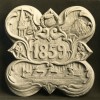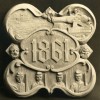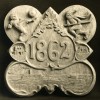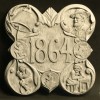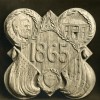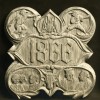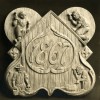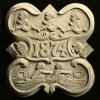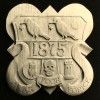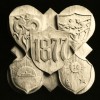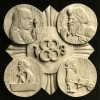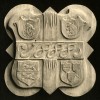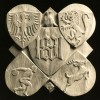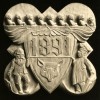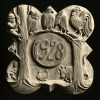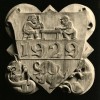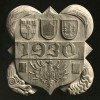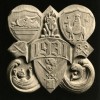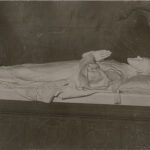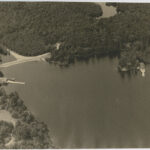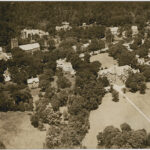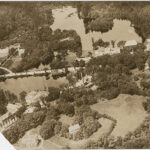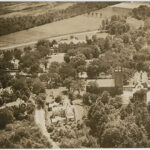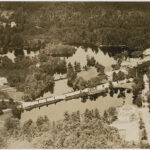This online exhibit presents a selection of photos found in the St. Paul’s School archives of the carvings done by John Gregory Wiggins during Samuel Smith Drury’s tenure as Rector. Descriptions of the symbolism represented in the plaques come from printed accounts provided in the Alumni Horae and the Horae Scholasticae. This represents only a small selection of the Form plaque carvings completed by Wiggins over the thirty-two years he worked on the project.
Click on the thumbnails above or the titles below to access the individual catalog pages.
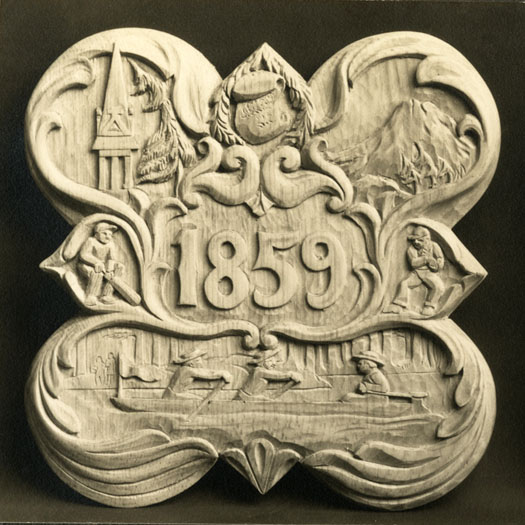
This photo is of the Form plaque carving for 1859 on display in the Coit Upper Dining Hall that was completed by woodcarver John Gregory Wiggins sometime between November of 1922 and May of 1923.
The following description of the design was written by Wiggins in the June 7, 1923 edition of the Horae Scholasticae:
The lower section shows the first recorded boat-race on the School pond, when the “Emily” was defeated by the “Magnolia,” and the “Undine” by the “Sintram.” Both races were for pair-oars with a coxswain. In the upper left-hand corner the Old Chapel tower is indicated, as during the Sixth Form year of this class the Old Chapel was consecrated. The upper right-hand corner shows a mountain top, as the entire School climbed Kearsarge this year. In both these panels the pines are shown bending before the wind, which prevailed very strong through the spring of this year. The corners of the shield show cricketers playing the game most popular in those days. This year the Olympians, the fore-runners of the Old Hundreds, beat the Isthmians. The upper center shows a scroll indicating the first School diplomas (this was the first form to graduate from S. P. S.).
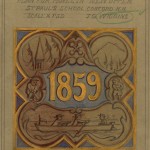 Click the thumbnail on the left to see the original concept drawing created by Wiggins as part of the design process for this carving.
Click the thumbnail on the left to see the original concept drawing created by Wiggins as part of the design process for this carving.
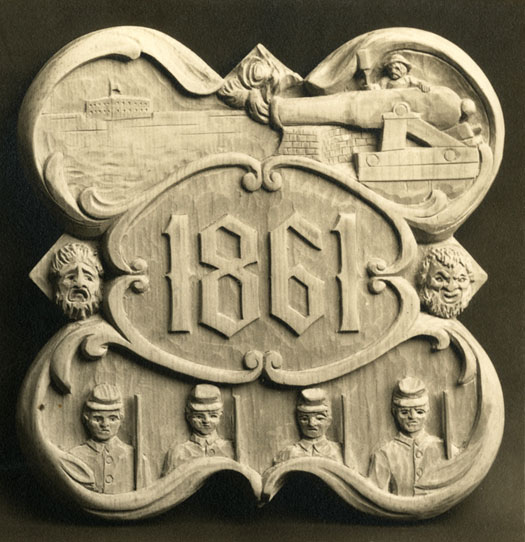
This photo is of the Form plaque carving for 1861 on display in the Coit Upper Dining Hall that was completed by woodcarver John Gregory Wiggins sometime between November of 1922 and May of 1923.
The following description of the design was written by Wiggins in the June 7, 1923 edition of the Horae Scholasticae:
The outbreak of the Civil War is suggested by Fort Sumter and an old-time cannon, the sort which was raised and lowered by using wooden wedges under the breech. The lower half of the panel shows the schoolboys drilling, and in the corners are a tragic and a comic mask to indicate the charades which were very popular as school entertainments at the time.
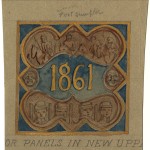 Click the thumbnail on the left to see the original concept drawing created by Wiggins as part of the design process for this carving.
Click the thumbnail on the left to see the original concept drawing created by Wiggins as part of the design process for this carving.
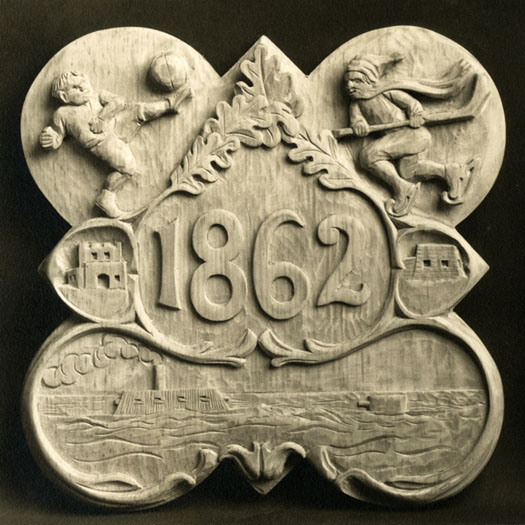
This photo is of the Form plaque carving for 1862 on display in the Coit Upper Dining Hall that was completed by woodcarver John Gregory Wiggins sometime between November of 1922 and May of 1923.
The following description of the design was written by Wiggins in the June 7, 1923 edition of the Horae Scholasticae:
The lower half of the shield shows the famous encounter between the Monitor and the Merrimac. In the corners are forts, suggesting the taking of Forts Henry and Donelson. In the top center is a bunch of oak leaves – the Battle of Fair Oaks. In the upper left is foot-ball, which was played quite a bit that fall; and upper right shows “Shinny on the ice,” the first sign of life in “The Cradle of Hockey.”
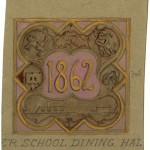 Click the thumbnail on the left to see the original concept drawing created by Wiggins as part of the design process for this carving.
Click the thumbnail on the left to see the original concept drawing created by Wiggins as part of the design process for this carving.
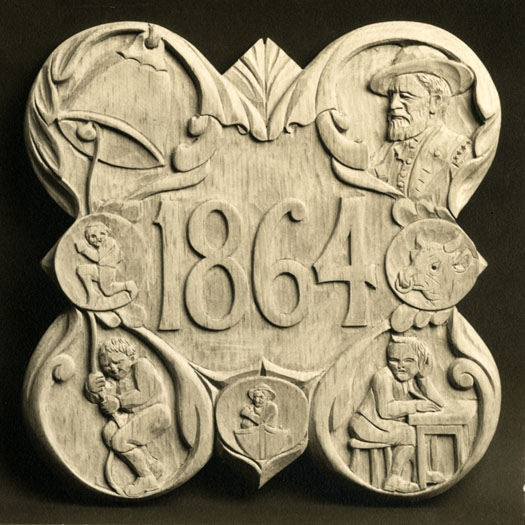
This photo is of the Form plaque carving for 1864 on display in the Coit Upper Dining Hall that was completed by woodcarver John Gregory Wiggins sometime between November of 1922 and May of 1923.
The following description of the design was written by Wiggins in the June 7, 1923 edition of the Horae Scholasticae:
The upper and lower left show a boy ringing a bell, commemorative of the continued Federal success, and the new School bell which was installed during that year. The upper right is a likeness of U. S. Grant who took command and pushed Lee so vigorously at this time. The Rural Record tells us that the carpenters would not co-operate with the School while at work. (A new school-house was being built then.) The scholars were much disturbed by the continual hammering. The lower right shows a boy at his desk with mind distraught. From the same source we hear of a holiday given because of the extra fine weather when three separate parties paddled down the Sluice to the Merrimack (lower center). In the same year a boy narrowly escaped being gored by a bull (right and left corners).
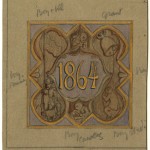 Click the thumbnail on the left to see the original concept drawing created by Wiggins as part of the design process for this carving.
Click the thumbnail on the left to see the original concept drawing created by Wiggins as part of the design process for this carving.
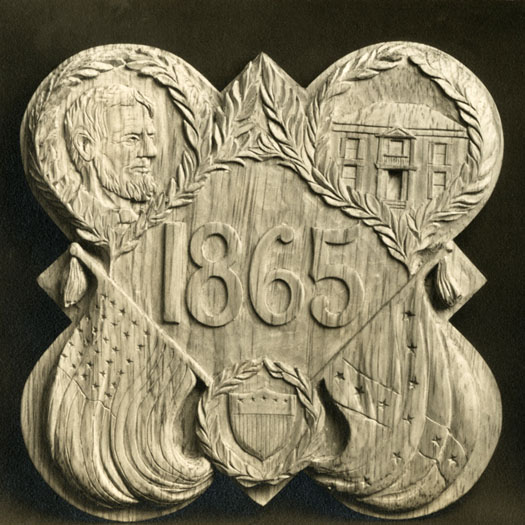
This photo is of the Form plaque carving for 1865 on display in the Coit Upper Dining Hall that was completed by woodcarver John Gregory Wiggins sometime between November of 1922 and May of 1923.
The following description of the design was written by Wiggins in the June 7, 1923 edition of the Horae Scholasticae:
In the upper right is Abraham Lincoln; in the upper left, Appomattox Courthouse. The lower part of the shield shows “Stars and Stripes” and “Stars and Bars” crossed.
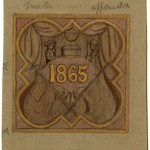 Click the thumbnail on the left to see the original concept drawing created by Wiggins as part of the design process for this carving.
Click the thumbnail on the left to see the original concept drawing created by Wiggins as part of the design process for this carving.
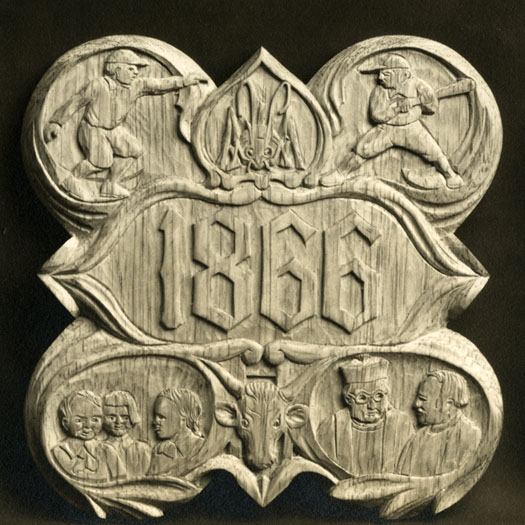
This photo is of the Form plaque carving for 1866 on display in the Coit Upper Dining Hall that was completed by woodcarver John Gregory Wiggins sometime between November of 1922 and May of 1923.
The following description of the design was written by Wiggins in the June 7, 1923 edition of the Horae Scholasticae:
The upper half shows baseball springing up beside cricket. In this year there were two ball clubs, the Alerts and the Fearnoughts, and the former was victorious. Lower center shows a cow’s head, marking the building of a new farm. The lower left shows a group of orphans, and the lower right two of the clergy, as in this year the Orphans’ Home was opened by Dr. Coit, and there was a Church Convention in Concord, the members visiting the School during their stay.
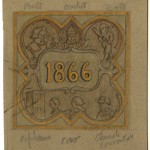 Click the thumbnail on the left to see the original concept drawing created by Wiggins as part of the design process for this carving.
Click the thumbnail on the left to see the original concept drawing created by Wiggins as part of the design process for this carving.
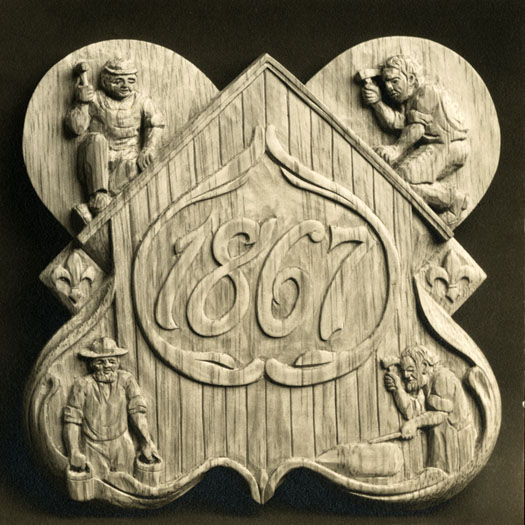
This photo is of the Form plaque carving for 1867 on display in the Coit Upper Dining Hall that was completed by woodcarver John Gregory Wiggins sometime between November of 1922 and May of 1923.
The following description of the design was written by Wiggins in the June 7, 1923 edition of the Horae Scholasticae:
This panel shows “Old Number 3” with the carpenters shingling the roof. This year was excessively dry and water had to be brought to the School. Lower left shows a farmer carrying buckets of water. The old Smithy was torn down. The lower right shows a blacksmith at work. This year a certain M. Lalanne came to the School and taught French, which marks the beginning of that department, hence the fleur de lis in the corners.
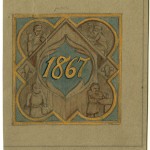 Click the thumbnail on the left to see the original concept drawing created by Wiggins as part of the design process for this carving.
Click the thumbnail on the left to see the original concept drawing created by Wiggins as part of the design process for this carving.
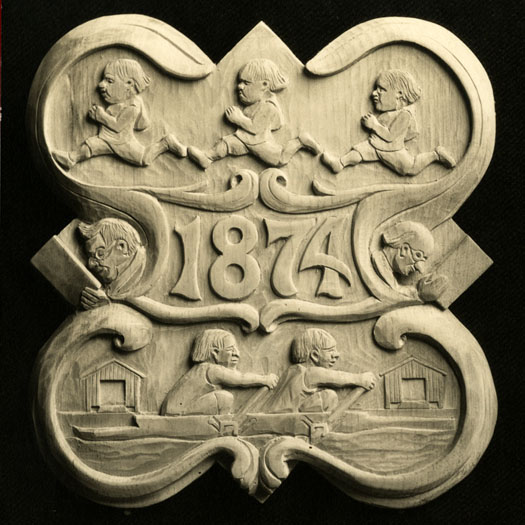
The following description was written by John Gregory Wiggins in the June 6, 1929 edition of the Horae Scholasticae:
This year was marked by the first regular track meet on the lower grounds, as indicated at the top of the shield. In the corners are two bibliophiles poring over their books, in memory of the Library Association which came into being at this period. The first double scull race took place in this year, and such a crew is depicted on the lower part of the shield, rowing past the two new boathouses which were also built at this time.
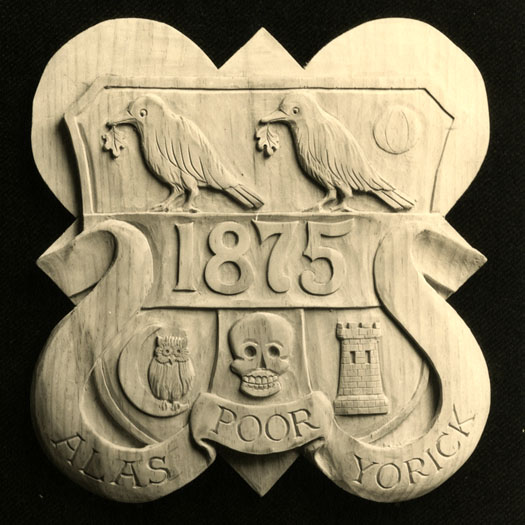
The following description was written by John Gregory Wiggins in the June 6, 1929 edition of the Horae Scholasticae:
This panel, though very pure in its simplicity, is nevertheless full of meaning and very cryptic. The Horae of this year is full of allusions to Shakespeare, and many scenes from his plays were acted. Hence the quotation beneath the skull. This gruesome symbol has, however, another signification, as it marks the acquisition of a new single scull at Long Pond. The castle marks both the erection of a new school building and the reorganization, or, rather, rebirth, of the chess club. The connection of the owl and the moon marks this year as the one in which the Horae became a monthly publication. The robins with the oakleaves in their bills commemorate the performance of the Babes in the Wood, as well as an increasing interest in ornithology, which became evident at this time.
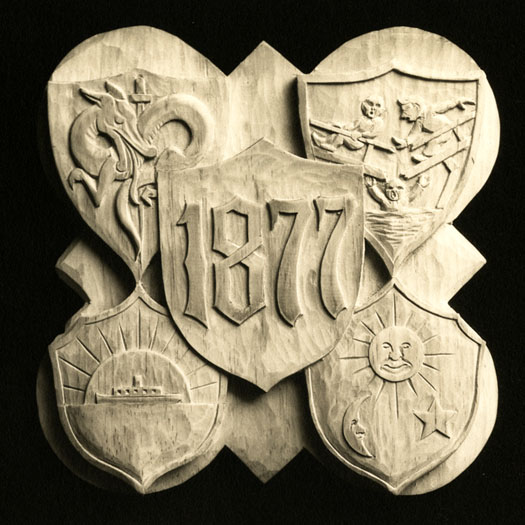
This unattributed description, most likely written by John Gregory Wiggins, appeared in the Spring 1932 edition of the Alumni Horae:
This year is commemorated by four small shields. In the upper left we have a dragon pierced by the sword of St. Paul, marking the victory of the School Eleven over St. George’s Cricket Club. The breaking of the footbridge over the School Pond is shown on the other side. The little steamer Penacook made its last appearance on the Pond this year, and a series of astronomical lectures was delivered during the year.
Click HERE to access a PDF of the Alumni Horae article.
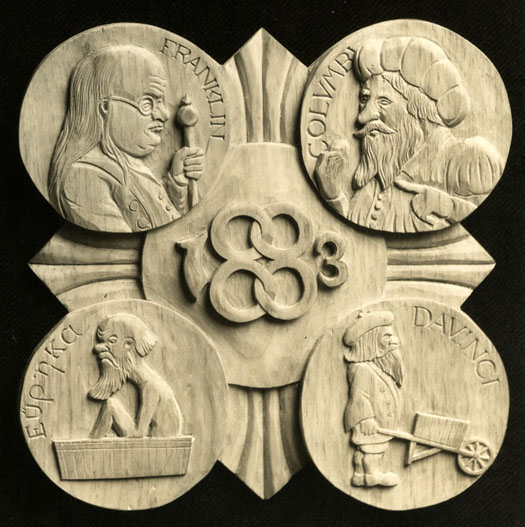
The following description was written by John Gregory Wiggins in the June 6, 1929 edition of the Horae Scholasticae:
At the beginning of this School year was formed the Scientific Association, which important event seems to warrant a shield all to itself. Four medals have been struck off and placed in the corners of the quatrefoil, representing great moments in science. First: Dr. Franklin holding a lightning rod; 2d, Christopher Columbus showing just how to break an egg; 3rd, Leonardo da Vinci, having just completed the invention of the wheelbarrow; and Archimedes, of Syracuse, in the act of discovering the laws of specific gravity in his bathtub, and just about to shout “Εύρηκα!”
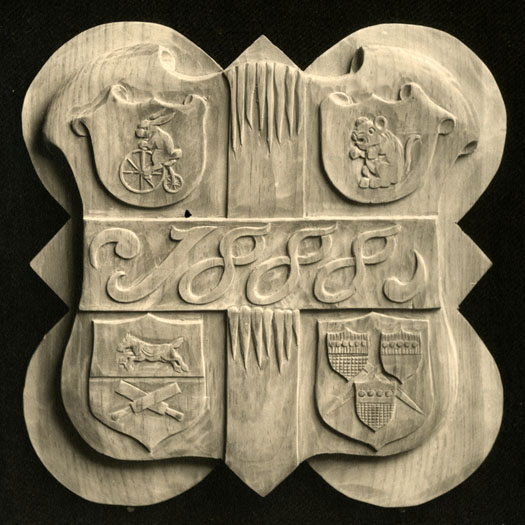
The following description was written by John Gregory Wiggins in the June 6, 1929 edition of the Horae Scholasticae:
This being the year of the great blizzard, we have icicles shown to mark the fact. A hare and hounds’ bicycle race took place this year (upper left). (Upper right) a peculiar animal on a shield. Some such animal was seen that spring on an ice block floating down the pond. There was much discussion as to whether it was an otter, mink or beaver. This, too, was an outstanding cricket year. Also the cricket horse ran away (lower left). VI, V, and IV form football clubs were organized: VI, black and red; V, white and red; IV yellow and black. This is heraldically indicated in the lower right hand corner.
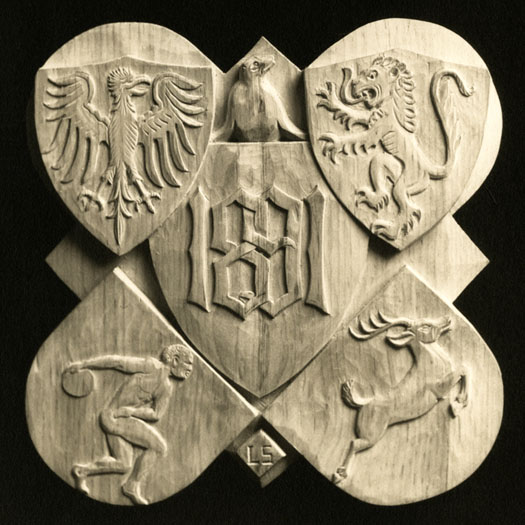
This unattributed description, most likely written by John Gregory Wiggins, appeared in the Spring 1932 edition of the Alumni Horae:
The Horae of this year gives an account of the Behring Seal Dispute between Great Britain and the United States. So at the top of the shield we have an eagle and a lion rampant with a seal between. At the bottom of the panel we have indicated the corner stone of the new Lower School which was laid that year. Speed and accuracy were shown to a marked degree at this time in the track and field events, hence the discobolus and the fleet-footed stag. The Greek athlete also reminds us of the activities of the American School at Athens and the excavations in Rome at this period. A large buck also was seen very near the School during the Fall term.
Click HERE to access a PDF of the Alumni Horae article.
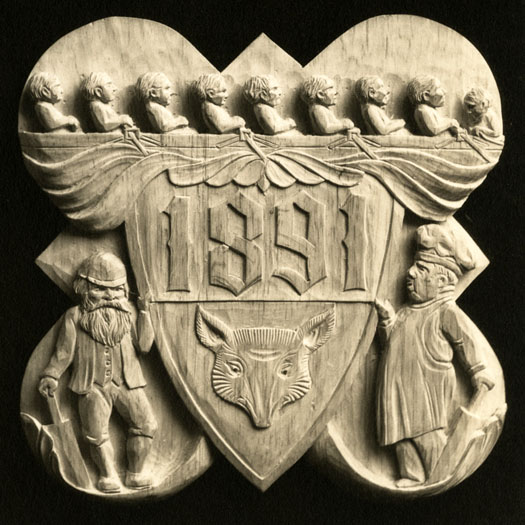
This unattributed description, most likely written by John Gregory Wiggins, appeared in the Spring 1932 edition of the Alumni Horae:
Eights were first used in the boat clubs this year, hence the crew used as a crest for this shield. As supports we have two cricketers, one Sam Morley, and one a Miller, the Miller’s House A. A. having challenged the School this year. The fox’s head in the lower section of the shield reminds us of Morley’s shooting of a very large fox on the School grounds this year. In the Birmingham News of this year we find the following: “Many Birmingham Cricketers will be pleased to hear that old Sam Morley who left this city for America a few years ago is still in the flesh and playing as well as ever. Sam Morley is a wonderful old man of 67 and still an active cricketer.”
Click HERE to access a PDF of the Alumni Horae article.
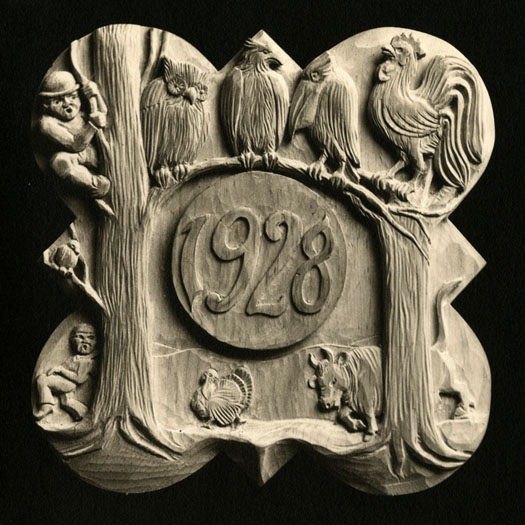
This unattributed description, most likely written by John Gregory Wiggins, appeared in the Spring 1932 edition of the Alumni Horae:
This panel shows a rural scene with a rising moon on which the numerals appear. The roosting birds, owl, eagle, pelican, and cock stand for the four new dormitories. The turkey hurrying below, reminds us of the revival of the Turkey run, abandoned a few years before. The charging bull calls to mind that two members of the faculty, both men of dignity and presence, were chased by such an animal about this time. One took refuge in a tree. The other during his escape noticed the only prothonotary warbler ever seen in New Hampshire. The warbler is indicated on a lower branch.
Click HERE to access a PDF of the Alumni Horae article.
The Horae Scholasticae of June 6, 1929, has this to add:
St. Paul’s School is credited with a notable feat in the discovery hereabout of the Prothonotary Warbler, by Mr. Welsh. This warbler’s normal habitat is in the Mississippi Valley, and the regions adjoining, so that its presence in these localities is a little short of phenomenal, and seems quite inexplicable. It has never before been observed so far north, or, if observed, no record of the fact exists.
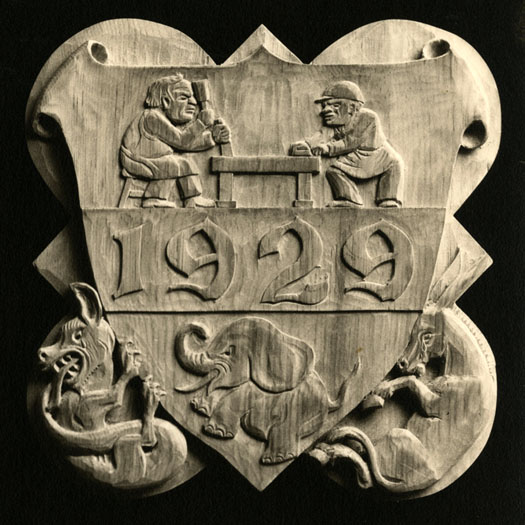
This unattributed description, most likely written by John Gregory Wiggins, appeared in the Spring 1932 edition of the Alumni Horae:
During the year a tremendous amount of building was going on and so we find artisans at work at the top of the shield. In the lower portion we see a joyous elephant, marking the outstanding Republican victory in the Presidential election. As supports we have two animals in tears, the Democratic ass, and the St. George’s School dragon mourning the loss of the football game with S.P.S.
Click HERE to access a PDF of the Alumni Horae article.
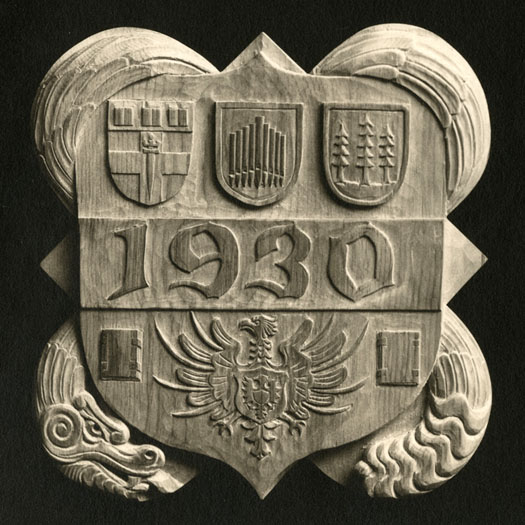
This unattributed description, most likely written by John Gregory Wiggins, appeared in the Spring 1932 edition of the Alumni Horae:
Three small coats of arms are found at the top of the shield, one to recall the victory over Groton in debating, one the installing of the Knox Memorial organ, and the Isthmian shield to record the first Isthmian championship in football in nineteen years. In the lower section of the shield we have a German eagle with a tome on either side, to record the memorial German library in Mr. Spanhoofd’s old quarters. Around the shield is twined the feathered serpent of the Aztecs to remind us of the lecture on Central American archeology by Mr. Morley.
Click HERE to access a PDF of the Alumni Horae article.
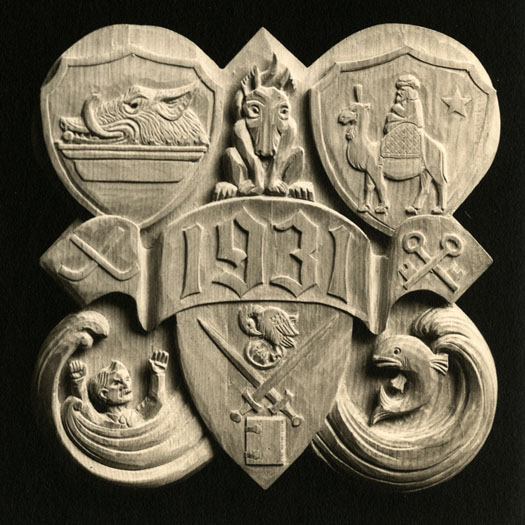
This unattributed description, most likely written by John Gregory Wiggins, appeared in the Spring 1932 edition of the Alumni Horae:
This was a picturesque year in which occurred a Gaudy, recorded by a boar’s head on a charger, and a Christmas pageant, shown by one of the magi on a camel. In the lower section we have the new St. Paul’s School coat of arms set in the midst of a raging sea, in which we find a swimmer and a conventionalized shad, leaping. This is to mark the event of the Shattuck president’s accident at the Pond, and the surprise occasioned to the Shattucks. On the ribbon on either side of the date we have crossed hockey sticks and keys, to mark an undefeated hockey team, and four ΦBK elections. The peculiar animal at the top is to recall the appearance of a mysterious beast on the ice whose species could not be determined. The Horae noted the fact thus: “On the 6th of December the peculiar animal seen at St. Paul’s in 1888, 42 years ago, appeared again on the ice in the Library Pond. We shall be interested to see if the Horae of 42 years hence makes mention of such a beast.”
Click HERE to access a PDF of the Alumni Horae article.

 Click the thumbnail on the left to see the original concept drawing created by Wiggins as part of the design process for this carving.
Click the thumbnail on the left to see the original concept drawing created by Wiggins as part of the design process for this carving.